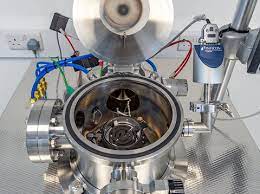Chemical Vapor Deposition (CVD) is a thin-film deposition process used to create coatings, films, or layers on various substrates. Here’s how CVD works:
Gaseous Precursors: The process begins with introducing gaseous precursors, often in the form of volatile compounds, into a reaction chamber or reactor.
Chemical Reaction: The precursors are subjected to controlled conditions, such as temperature and pressure, within the reactor. Under these conditions, the precursors undergo chemical reactions, breaking down and forming new molecules.
Surface Adsorption: The newly formed molecules or particles are carried by the gas phase and transported to the substrate’s surface. Upon reaching the substrate, these molecules adsorb or adhere to the surface.
Film Growth: As more precursor molecules continue to react and adsorb on the substrate surface, a continuous layer of the desired material starts to grow. The thickness of the film is controlled by adjusting factors such as the flow rates of the precursors and the reaction time.
Substrate Temperature Control: The temperature of the substrate is a crucial parameter in CVD. It affects the rate of chemical reactions, the kinetics of film growth, and the resulting material properties. By carefully controlling the substrate temperature, researchers can achieve the desired film quality and characteristics.
Purging and Removal: In some cases, unreacted precursors and byproducts need to be removed from the reaction chamber to prevent contamination. Purging the reactor with inert gases ensures the removal of unwanted residues.
Film Quality and Properties: The characteristics of the deposited film, such as its composition, thickness, and crystallinity, are influenced by parameters like precursor concentrations, temperature, pressure, and reactor design.
CVD enables precise control over film composition, thickness, and material properties, making it a versatile technique used in various industries, including microelectronics, optics, coatings, and more. It’s a vital tool for producing functional and advanced materials with tailored characteristics




